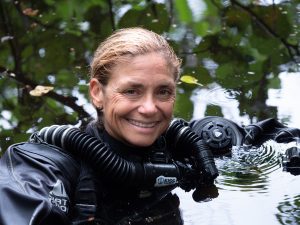Born in Italy, Cristina grew up in the Congo, where she developed a love for the outdoors, wildlife and oceans. Her father’s images in the ARA Rebreathers used in the Italian special forces “Arditi Incursori” inspired her from a young age. In 1994, she traveled to The Bahamas to become an Open Water diver. In one week, she decided to leave her previous life and pursue a career in diving. A year later, she was a PADI Open Water Instructor with 400 logged dives.
Associated with her passion for water was her natural disposition to learn languages. Her studies brought her to master Italian, English, French, and German; and later add Spanish and ASL. Cristina combined her childhood passion for scuba diving with her gift and became a contributor to the need for conservation and exploration of the underwater world. Among her qualifications, she is a Course Director, NSS-CDS advanced cave diving instructor, and a TDI mixed gas and rebreather instructor. She shares her time between teaching at professional, technical levels, working with sharks, exploring and mapping underwater cave systems.
In the Bahamas, she has been responsible for the exploration and survey of several cave systems. She is also the first diver to connect an ocean blue hole with a land-based cave. This project was a history-making accomplishment. In 2020, together with just one additional team member, Kewin Lorenzen, she discovered and explored two new cave systems, bringing the exploration and mapping of these areas to over 15 miles in less than six months.
Cristina has been part of several expeditions, including the 2015 National Geographic, to survey Abaco’s crystal caves, the 2019 Channel Islands with Bob Ballard, and she has been featured on numerous TV programs, including BBC Blue Planet Live. Her work with advanced survey technology, creating interactive and 3D maps has been extensively used.
In 2019 she founded the nonprofit People of the Water www.pownonprofit.org, organized to widen the conduction and distribution of training, education, research, and studies relating to water, ocean, and environmental issues, affecting the people and the animals of said environments. After twenty-seven years in this career, she is still diving and pushing the boundaries of our knowledge. She still works as a diving professional and has collected over 20,000 dives; 4,000 in caves, over 10,000 with sharks.
Cristina is an inductee in the Women Divers Hall of Fame, a member of the Explorers Club, the Ocean Artists Society, and she is a Platinum Pro 5000 recipient.
How and why do you use checklists?
I started using checklists the moment I started scuba diving. In recreational diving, we learn checklists in mnemonics, while in the technical diving world, we tend to use written ones.
As someone who often switches from recreational to technical diving, passing through unique shark diving, my first checklist starts with my gear bag. I always physically identify the items I need for each specific dive and transfer them as required. For example, when working with sharks, I use two sets of diving socks, but I need my booties when working as an instructor at the recreational diving level.
If the project requires more than the usual gear, I carry the checklist on a clipboard and scratch the items off as I load them into the vehicle, the boat, or pack them for a trip.
My most extensive use of written checklists comes from my technical background, and it starts with my rebreather preparation list. I know each of the list points, but I always make sure to read it aloud and then complete the task, followed by a checkmark. This system prevents my mistake of skipping one item, forgetting it because I was interrupted and distracted and ultimately made a mistake in preparing my machine. My other checklist is on a slate and includes the pre-dive and in-water safety checks. Other lists, such as the head to toe in water used before submerging for a cave dive, assures us that the items in our bag make it on our kit and body.
There are pre-made checklists we can follow and create one that fits with our goal and our flow. For me, following a list removes the ultimate distraction, which is the question I would ask myself if I covered the necessary steps to prepare for the dive. This mental support reduces my pre-dive stress and helps with focus.
One checklist that I use before my dives is my wellbeing checklist. Time and experience in this industry taught me that there is nothing more important than the personal level of readiness.
From the moment I wake up, I go through a personal head-to-toe check.
I complete two reviews, one at a psychological level, reviewing if something occupies my mind or worries are distracting me from the preparation. I check my anticipation levels and the feeling of anxiety or stress and analyze if they are within acceptable levels or not. After the mental check, I examine the physical state. I travel through my body and make a note of each part. I check if I already have a minor headache or a strain anywhere in the body. This personal assessment is the list that makes me decide to participate or call the day. It is an essential list; it provides safety for myself and those in the team. If I decide I am ok with the dive, I still use the checklist to compare during and after the dive knowing how my body and mind function while under pressure.

